I suppose I gave away the ending of this story via the title of the blog. But don’t worry, I think you’ll enjoy the story (unfortunately, the victims and their relatives didn’t).
I previously introduced you to the infamous French serial killer, Dr. Marcel Petiot, in my blog Dr. Jekyll and Mr. Hyde (click here to read). I jokingly refer to him as “Jacques the Ripper.” Today, I’d like you to meet another serial killer who, in the early 20th century, became known as the “French Bluebeard.” Ironically, his beard was red and not blue. Despite different circumstances, he and Dr. Petiot met the same fate.
Did You Know?
Did you know we get the most hits on our blog posts when we use the word “guillotine” in the title?
Let’s Meet Henri Désiré Landru
Henri Désiré Landru (1869−1922) was born in Paris to working class parents. They were so overjoyed they bore a son that they gave him the middle name Désiré which means “much desired.” By all records, Henri’s mother and father provided a loving family atmosphere and did an exceptional job at parenting the boy. Henri was schooled by monks, served as an altar boy, and sang in the church choir. Henri was very intelligent and by the age of sixteen, he was studying mechanical engineering.
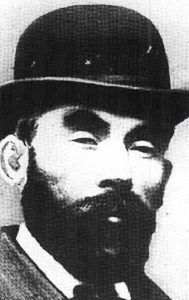
At the age of eighteen, Henri began his four-year service in the French army and eventually reached the rank of sergeant. After his discharge are when the problems began. Henri had been raised in relative poverty and he made the decision he would not return to that life style, whatever the cost.
Within two years of leaving the military, Henri had married his cousin and ultimately sired four children. Instead of finding gainful employment, Henri decided to pursue a life of crime and started with petty theft. He landed in jail many times and never showed any remorse for his actions. His father was so distraught over his son’s behavior that he hanged himself believing he had failed as a parent.
The Bluebeard Fairytale
The popular late-17th-century French fairytale of “Bluebeard” tells the story of a very violent but powerful man (with a blue beard because he was of the aristocracy—in other words, a blue blood) who murders his wives for disobeying him. After killing them, he would hang their bodies on hooks in a basement room of his large château. The French folk tale was inspired by the 15th-century Breton serial killer, Gilles de Rais (c. 1405−1440).
His last wife, the youngest daughter of a neighbor, was given a set of keys by Bluebeard with the admonishment that she could go anywhere in the château except for the locked basement room. Then he was off on a trip and left his wife all alone in the château.
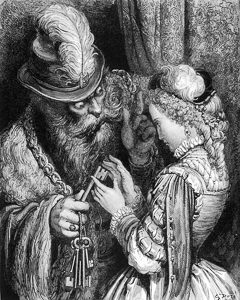
After a while, she grew naturally curious about what was inside the locked room. One day, she took the keys, opened the door, and stepped into the room. There she was faced with the hideous remains of her husband’s previous wives. The floor was covered in blood and at one point, she dropped the keys and they became stained red.
When Bluebeard returned, he asked for the keys and became enraged when he saw the blood. He knew she had disobeyed his orders and had entered the room. Bluebeard became violent and threatened to kill her. As he dragged her to meet a similar fate as her predecessors, her brothers showed up in the nick of time and killed Bluebeard. The wife buried Bluebeard’s former wives’ remains and inherited his fortune along with the château.
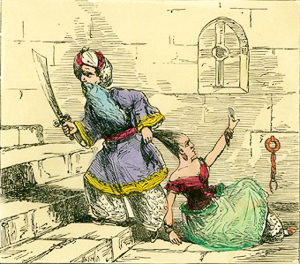
Like most fairytales (and I know there are some holes in the story), the ending had everyone living happily ever after. Well, at least everyone except Bluebeard and his former wives save one. Henri’s story will end the same way.
Landru the Widower
Like Bluebeard, Henri Désiré Landru was physically unattractive but he was extremely intelligent and charming. He used these attributes to attract middle-aged women who were wealthy, trusting, and looking for love. By 1914, Landru was forty-two and one thing that worked to his advantage was that most of the French men had gone off to serve in World War I. This left a dearth of potential male companions for lonely women.
Although still married (but not living together), Landru began to “market” himself as the widower, Monsieur Diard. His first conquest was Jeanne Cuchet. Landru moved in with Madame Cuchet and her eighteen-year-old son. Soon, both mother and son disappeared and Landru inherited her estate. One year later in 1915, Landru moved to the Villa Ermitage located in Gambais, France (west of Versailles) where he took on various names and lured eight women over the next six years. Some he falsely married, some he lived with, and some he only dated. One thing was certain. By 1921, Henri Désiré Landru was a very wealthy man.

After living in Gambais for four years, Landru had moved to an apartment in Paris located at 76, rue de Rochechouart and began trolling the high-end restaurants for his next prey. Each victim was carefully chosen based on their net worth. However, eventually several relatives of the missing women began to become suspicious. Two of them brought their suspicions to the mayor of Gambais who in turn, contacted the Paris police. For the Parisian Bluebeard, the jig was just about up.
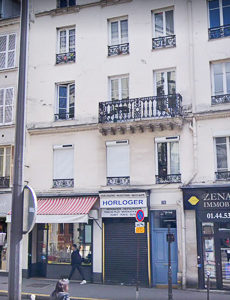
Caught Like A Trapped Rat
The Paris police issued an arrest warrant for Landru on 11 April 1919 and the gendarmes traced him to his apartment. Knocking on his door triggered a panic attack and Landru threw his diary out one of the front windows. The authorities found it and discovered a complete history of each victim, the dates he was with them, their wealth, and exactly what he intended to get out of the relationship.
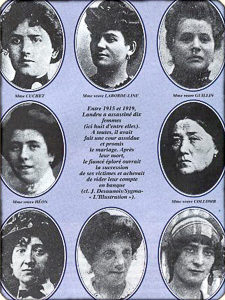
At this point, the police had enough to arrest Landru and search not only his Paris apartment but also his house in Gambais. Similar to the story about Dr. Petiot, neighbors had seen smoke coming from the house’s chimney for many years. When the police searched the house, they found hundreds of bone and teeth fragments. Examining the kitchen stove, it was determined that Landru had burned the bodies (likely parts of bodies) in the stove. They also found the womens’ clothes and personal items (in the case of Dr. Petiot, it was the victims’ suitcases). Landru couldn’t (or wouldn’t) answer any of the questions posed by the police and he refused to admit any guilt.
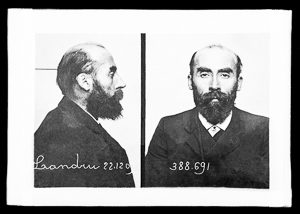
Trial By A Jury of His Peers
Landru was charged with eleven murders in November 1921 (ten women and the teenage boy). He refused to discuss any part of the case because it would be disrespectful to his wife (yes, throughout all this, Landru stayed married to Remy). Landru’s defense was that he was a slave trader and shipped the women off to a Brazilian brothel—that story didn’t save him.
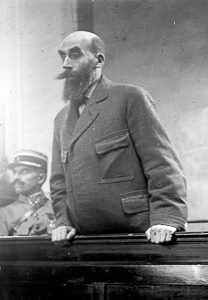
Landru was convicted of the murders (although the police thought there were many more killed than the eleven he was charged with). The judge sentenced him to death despite the jury’s request for clemency. While in prison, Landru sketched an image of his kitchen sink and wrote an inscription on the back which was interpreted as, “I did it. I burned their bodies in my kitchen stove.” He gave the sketch to his attorney.
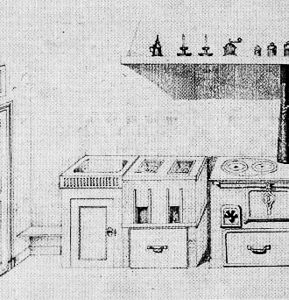
The condemned man talked the authorities out of cutting his long beard before his execution. The guillotine was set-up outside the Versailles prison and on 25 February 1922, Henri Désiré Landru was strapped down on the plank with his head placed in the lunette. His last words were, “I shall be brave.”
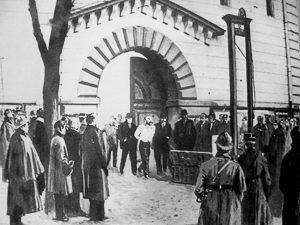
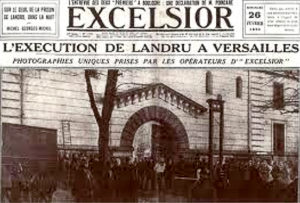
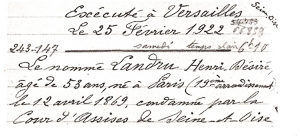
The Parisian Bluebeard with the red beard was buried at Cimetière des Gonards, Versailles in an unmarked grave (somehow, his severed head ended up on display at the Museum of Death in Hollywood, California). Other than the note, Landru never formally admitted anything and ultimately took all of the details with him to his grave. See more of the Museum of Death here.
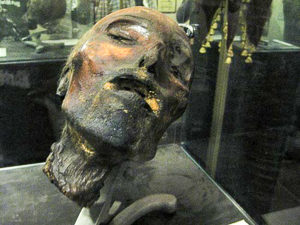
Recommended Reading and Viewing
Tomlinson, Richard. Landru’s Secret: The Deadly Seductions of France’s Lonely Hearts Serial Killer. Barnsley, UK: Pen & Sword Books, 2018.
What’s New With Sandy and Stew?
We returned yesterday from our trip to the Amazon River. I’ll have some travelogue comments in our next blog (22 December). That blog is entitled, The Rabbits of Ravensbrück (click here to read).
Someone Is Commenting On Our Blogs
If you enjoy our blogs, please tell a friend who might have an interest in the history we comment on. If there is a topic you’d like to see a blog written about, please don’t hesitate to contact me. I love hearing from you so keep those comments coming.
Why Would You Want To Buy Our “Walks Through History” Books?
Simple.
You like to travel and experience history and historical events. You like to see original buildings that had a significant impact on the people and events of the history you’re engaged with. You want to know the stories behind the brick and mortar in front of you.
The walking tour books are meticulously researched so you can go directly to those sites and learn about the building’s history as well as an introduction to some of the more interesting people associated with it.
Thank You
Sandy and I appreciate you visiting with us. We have some exciting things on the horizon and we’ll keep you updated as we go along.
Share This:
Follow Stew:
Find Stew’s books on Amazon and iBooks.
Please note that we do not and will not take compensation from individuals or companies mentioned or promoted in the blogs.
Copyright © 2018 Stew Ross

